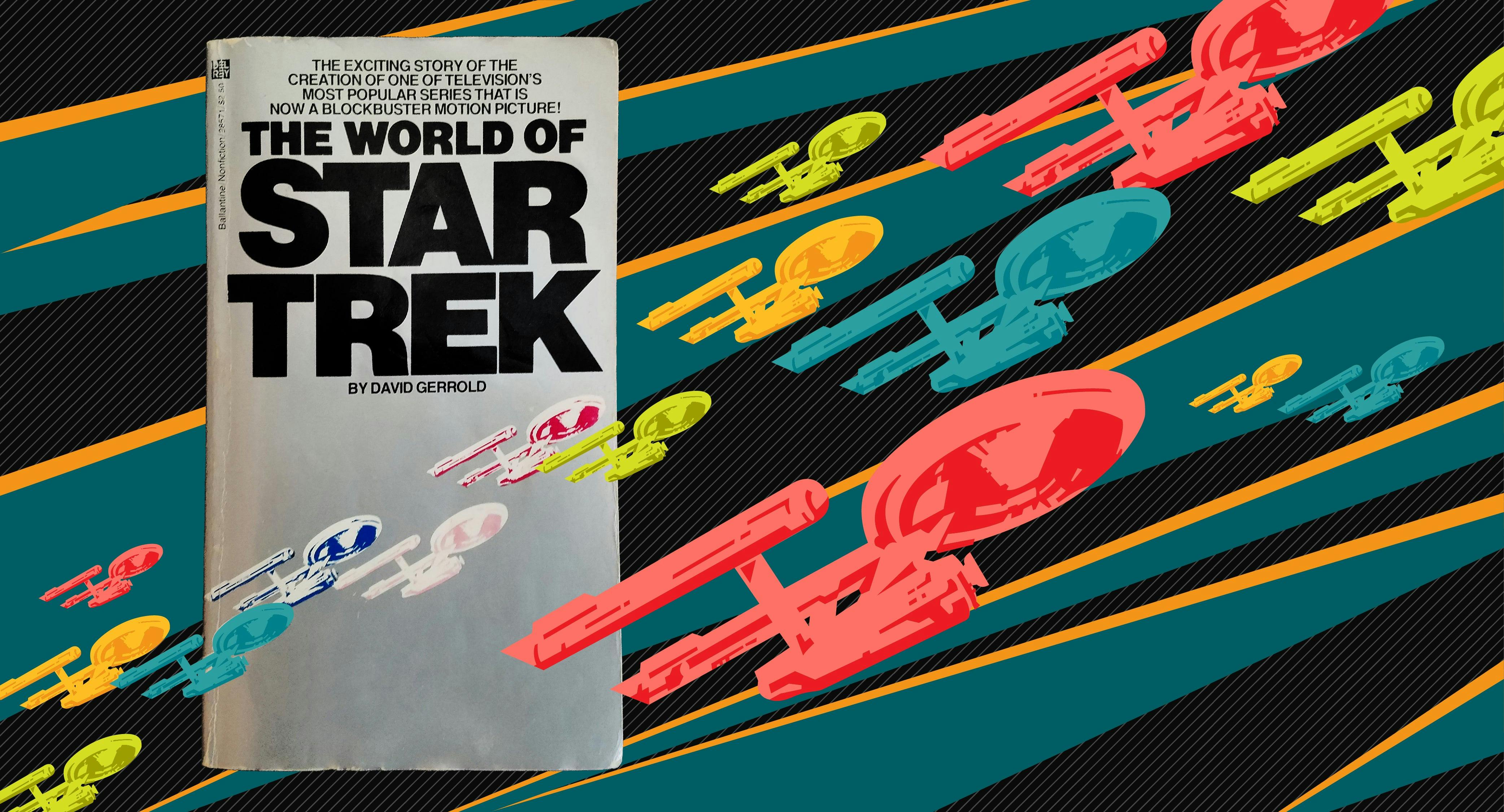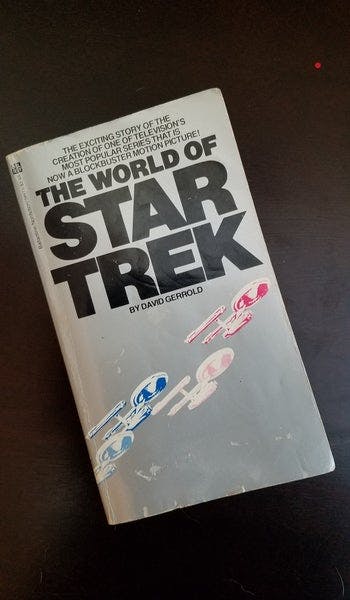Published Feb 9, 2021
Revisiting the World of Star Trek
Looking back at one of the first books to explore Star Trek and its devoted fandom, and the close relationships the show has helped fans bolster.

StarTrek.com
“A Trekkie not only keeps tabs on everyone involved with Star Trek, she—(generally, Trekkies are adolescent or post-adolescent girls, but not always) — she collects film clips, publishes fanzines, writes her own Star Trek stories — usually with herself as heroine, she keeps scrapbooks, she sews up costumes and uniforms for herself to match the ones on the show, she learns how to make herself up as a Vulcan, she corresponds endlessly with other Trekkies, and so on.”
The early 1970s were a precarious time for Star Trek. The show was over. There was no sprawling franchise. There was not even the expectation of a sprawling franchise. Star Trek was the five-year mission of Captain Kirk and Mr. Spock, prematurely canceled after three seasons and a Saturday morning cartoon.
“For a while, there was a group of girls who were practicing black magic rituals designed to make their favorite Star Trek stars fall in love with them.”
I have long been curious about the Star Trek fandom during this time. These were the Trekkies who made the show popular in syndicated reruns, who kept Star Trek alive despite the show being, factually, dead. My father was a fan of this era, though he never would have called himself a Trekkie. He just liked the show. He was an immigrant from India, who came to Canada and then the United States for graduate school. I am told that college campuses in the 1970s were notorious breeding grounds for Star Trek fans.

StarTrek.com
“Leonard Nimoy was on a promotional tour one time. When he walked into his hotel room in Chicago, the phone rang. He answered it—it was Susan from Colorado. He chatted with her for a bit, then hung up. A few minutes later, the phone rang again, this time it was Diane from Miami. He chatted with her for a while, then begged off because he had to get ready for an appearance that evening. A few moments later, the phone rang again. This time, it was Gail in New York. Intrigued, Leonard asked how they all knew where he was. Oh, replied the girl. Susan from Colorado called Diane in Miami who called her in New York.”
A few years ago, I discovered in a used bookstore a worn copy of The World of Star Trek by David Gerrold, first published in 1973. The book captured the state of Star Trek in that moment, including oral histories from the cast, speculation about a revival, and an exploration of the fandom.
In describing the fans, I expected the book to tell me about people like my father: male college students, who began watching Star Trek almost as an academic rite of passage. Instead, I discovered a fandom of mostly girls and young women, akin to modern day Beliebers or Directioners:

StarTrek.com
“‘We opened all the mail,’ [Bjo Trimble] said. ‘Whether it was personal or not. After a while, you got the feeling of being a voyeur—especially after reading seventeen page letters to William Shatner describing in great detail what certain women had in the way of daydreams about him…
“‘One girl wanted William Shatner to come to her graduation and stay overnight at her house and go with her to the prom. She pointed out that this would give her a good deal of status among her girl friends—especially his staying overnight at the house. And then ended her letter with, “In case you’d like to know what you’re getting into, here’s my picture…” We’re still not awfully sure if she understood what she was saying or not.’”
Half a century later, Star Trek has mellowed, so it can be hard to fathom that it once had the cachet of a cult rock band. The show was swashbuckling and sexy. Every week the Enterprise warped from adventure to adventure, often leaving behind Captain Kirk’s shirt and a broken heart. Trekkies were like groupies, the book postulated, and it was not just William Shatner who they treated like a rock star:
“One of the main focuses of the fan mail, of course, was Mr. Spock. Leonard Nimoy’s characterization of the half-alien, half-human First Officer touched a particularly responsive chord in a lot of little girls—and a lot of big girls too. The pointed ears and arched eyebrows suggested great strength and masculinity with a healthy hint of controlled evil…
“Actually, it may have been more than that. Deep down inside, each of these little girls—and the big girls too—believed that she was the one who could warm up Mr. Spock. If she could be given half a chance, she could get through to him.
“And if she couldn’t, well then that was just proof that no one could.”

StarTrek.com
In the oral histories, the cast members discussed their fan encounters, with a rare freshness that came with the book being published just four years after the show’s cancellation. Seasoned veterans of the convention circuit, they were not. DeForest Kelley fondly recalled a letter containing an illicit substance and the note, “Dear DeForest, you have turned me on so many times, I would like to repay the favor.” James Doohan was once shaken to find a young woman on his patio. She had been waiting there for eighteen hours. He bought her a soda at a drugstore and put her on a bus home. Walter Koenig hosted a fifteen-year-old girl and her mother on the set, during the show’s run. They were still in touch: The young woman was in college, studying literature and drama.
They were all rock stars, and nobody knew how long it would last.
Doohan, presciently, suggested a series of movies, “like the way Planet of the Apes has been handled.”
The back half of the book explored the friction between Trekkies and seasoned sci-fi fans of the time. The contrast neared parody, with the latter group described as generally male, wearing glasses, and believing Star Trek to be “junk” and “the lowest common denominator in science fiction.” Into their conventions came the Trekkies, who “only wanted to talk about Kirk and Spock and the Enterprise.” The situation was untenable, resulting in Trekkies eventually organizing their own conventions. From there came the Star Trek fanzines, the merchandise, and the talk of a revival.
My father wore glasses, and he never went to conventions. He just liked the show. His fandom waned once he married my mother and began raising a family. My own introduction to Star Trek came as a child: We went to Blockbuster Video, where my father rented Star Trek III: The Search for Spock. The film, for all its merits, was possibly the worst entry point to the franchise. Spock was dead (who was Spock?), and at the climax the Enterprise exploded (what?). Only years later did I understand why he chose that movie. He was catching up. He had not seen anything past Star Trek II: The Wrath of Khan.
Growing up, after I was sent to bed, he would watch Star Trek: Deep Space Nine and Star Trek: Voyager. I would sneak into the hallway and listen, as I did not have an angle to see the TV screen. Once I was old enough, I was allowed to watch.
My father passed away some years ago. The last Star Trek film he saw was the 2009 reboot. His review, upon leaving the theater, was, “That may have been the best one since Wrath of Khan, if not better.” It is safe to say that elderly professors were not the target audience for the film, but Star Trek has never been about a target audience. It is what marketers call four-quadrant entertainment, for the young and old, for men and women, for casual fans and hardcore Trekkies, and for everyone in between.
“Star Trek has the greatest potential of any television series ever created.”
Nitesh Srivastava (he/him) is a writer and marketer who lives in Des Plaines, Illinois. You can find him on Twitter at @niteshsrivastav

